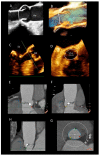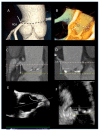Multimodality Imaging of the Anatomy of the Aortic Root
- PMID: 34064421
- PMCID: PMC8147821
- DOI: 10.3390/jcdd8050051
Multimodality Imaging of the Anatomy of the Aortic Root
Abstract
The aortic root has long been considered an inert unidirectional conduit between the left ventricle and the ascending aorta. In the classical definition, the aortic valve leaflets (similar to what is perceived for the atrioventricular valves) have also been considered inactive structures, and their motion was thought to be entirely passive-just driven by the fluctuations of ventricular-aortic gradients. It was not until the advent of aortic valve-sparing surgery and of transcatheter aortic valve implantation that the interest on the anatomy of the aortic root again took momentum. These new procedures require a systematic and thorough analysis of the fine anatomical details of the components of the so-called aortic valve apparatus. Although holding and dissecting cadaveric heart specimens remains an excellent method to appreciate the complex "three-dimensional" nature of the aortic root, nowadays, echocardiography, computed tomography, and cardiac magnetic resonance provide excellent images of cardiac anatomy both in two- and three-dimensional format. Indeed, modern imaging techniques depict the aortic root as it is properly situated within the thorax in an attitudinally correct cardiac orientation, showing a sort of "dynamic anatomy", which admirably joins structure and function. Finally, they are extensively used before, during, and after percutaneous structural heart disease interventions. This review focuses on the anatomy of the aortic root as revealed by non-invasive imaging techniques.
Keywords: aortic root; cardiac magnetic resonance (CMR); computed tomography (CT); echocardiography.
Conflict of interest statement
Francesco F Faletra speaker fees from Philips. Francesco Maisano: Grant and/or Research Institutional Support from Abbott, Medtronic, Edwards Lifesciences, Biotronik, Boston Scientific Corporation, NVT, Terumo. Consulting fees, Honoraria personal and Institutional from Abbott, Medtronic, Edwards Lifesciences, Xeltis, Cardiovalve, Occlufit, Simulands. Royalty Income/IP Rights Edwards Lifesciences. Shareholder (including share options) of Cardiogard, Magenta, SwissVortex, Transseptalsolutions, Occlufit, 4Tech, Perifect.
Figures










Similar articles
-
Multi-modality imaging evaluation and pre-surgical planning for aortic valve-sparing operations in patients with aortic root aneurysm.Ann Cardiothorac Surg. 2023 Jul 31;12(4):295-317. doi: 10.21037/acs-2023-avs2-0040. Epub 2023 Jul 10. Ann Cardiothorac Surg. 2023. PMID: 37554720 Free PMC article. Review.
-
Comparison of accuracy of aortic root annulus assessment with cardiac magnetic resonance versus echocardiography and multidetector computed tomography in patients referred for transcatheter aortic valve implantation.Am J Cardiol. 2013 Dec 1;112(11):1790-9. doi: 10.1016/j.amjcard.2013.07.050. Epub 2013 Sep 14. Am J Cardiol. 2013. PMID: 24045059
-
Anatomy of Mitral Valve Complex as Revealed by Non-Invasive Imaging: Pathological, Surgical and Interventional Implications.J Cardiovasc Dev Dis. 2020 Nov 4;7(4):49. doi: 10.3390/jcdd7040049. J Cardiovasc Dev Dis. 2020. PMID: 33158082 Free PMC article. Review.
-
Multimodality imaging in bicuspid aortic valve.Prog Cardiovasc Dis. 2020 Jul-Aug;63(4):442-451. doi: 10.1016/j.pcad.2020.06.003. Epub 2020 Jun 9. Prog Cardiovasc Dis. 2020. PMID: 32531300 Review.
-
Evaluation of aortic root for definition of prosthesis size by magnetic resonance imaging and cardiac computed tomography: implications for transcatheter aortic valve implantation.Int J Cardiol. 2012 Jul 26;158(3):353-8. doi: 10.1016/j.ijcard.2011.01.044. Epub 2011 Feb 18. Int J Cardiol. 2012. PMID: 21315460 Clinical Trial.
Cited by
-
Anatomical characteristics of aortic valve diseases: Implications for transcatheter aortic valve replacement.Eur J Radiol Open. 2023 Nov 8;11:100532. doi: 10.1016/j.ejro.2023.100532. eCollection 2023 Dec. Eur J Radiol Open. 2023. PMID: 38028187 Free PMC article.
-
Multimodality Imaging of the Anatomy of Tricuspid Valve.J Cardiovasc Dev Dis. 2021 Sep 3;8(9):107. doi: 10.3390/jcdd8090107. J Cardiovasc Dev Dis. 2021. PMID: 34564125 Free PMC article. Review.
-
Role of Runx2 in Calcific Aortic Valve Disease in Mouse Models.Front Cardiovasc Med. 2021 Oct 29;8:687210. doi: 10.3389/fcvm.2021.687210. eCollection 2021. Front Cardiovasc Med. 2021. PMID: 34778386 Free PMC article.
-
Extra-Cavity Image Registration via the Aortic Root During Left Ventricular Mapping and Ablation.Anatol J Cardiol. 2024 Feb 8;28(4):201-7. doi: 10.14744/AnatolJCardiol.2023.3264. Online ahead of print. Anatol J Cardiol. 2024. PMID: 38327189 Free PMC article.
References
-
- Faletra F.F., Leo L.A., Paiocchi V.L., Schlossbauer S.A., Pedrazzini G., Moccetti T., Ho S.Y. Revisiting Anatomy of the Interatrial Septum and its Adjoining Atrioventricular Junction Using Noninvasive Imaging Techniques. J. Am. Soc. Echocardiogr. 2019;32:580–592. doi: 10.1016/j.echo.2019.01.009. - DOI - PubMed
Publication types
LinkOut - more resources
Full Text Sources

